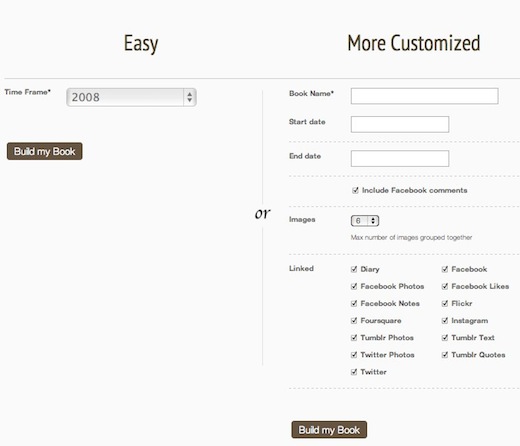
As the year is quickly coming to an end, it’s interesting to look back on the things you’ve shared on Facebook, Twitter, Tumblr and more. Like we said when the Facebook Timeline launched, it can sometimes be a little worrying to realise just how much you’re sharing on these social networks, but it also becomes a fascinating study of how you’ve spent your year.
If you’d like to see all that printed out in one book and saved for posterity, you can do just that with the new service Scribr. Slated to publicly launch at the end of January, Scribr lets you plug in your social media accounts – Twitter, Flickr, Facebook, Tumblr and Foursquare – and create a printed book of all of your updates, photos, check-ins and posts. You can also include your Instagram photos, but only if they are shared on your Facebook or Twitter accounts.
The Scribr Team
We caught up with one of Scribr’s co-founders, Adam Henson, a 27 year old North California native who now calls Silicon Valley home. A systems engineer by trade, Henson is joined by two other co-founders. Mark B., an accountant and Chris S., also an engineer, while Henson’s wife Trish, handles support and logistics.
Asking Henson what inspired them to launch Scribr, he told The Next Web
All of us have tried to keep a journal at some point. None of us had any success with it, and we knew that many other people had this same problem. One day a revelation struck: while we’re lamenting over the difficulty of keeping a journal, we’re unthinkingly documenting every aspect of our lives on sites like Facebook and Foursquare. We realized that this content would form a solid foundation for a journal with zero effort.
There’s a problem with preserving your life in any digital format – digital content is ephemeral and always changing; preserving it requires ongoing curation. To solve this problem, we looked to the past. Printed media, while not perfect, remains the most accessible and persistent means of storing information. I have journals passed down from my great-great grandfather; I can still hold this man’s 150 year-old life in my hands. So we set out to not only help you build the journal you’ve always wanted, but to preserve it in a durable format with only a few clicks.
The small California team has put together a service which makes it easy to create a journal made up, not only of your social media posts, but also of your private updates that no one else can see. After signing up for a Scribr account and connecting your social accounts, you can also sign up for a daily email reminder to send your private thoughts directly to your account.
How Scribr works
The service itself couldn’t be easier to use. Connect your accounts, and then choose between two options. Either generate a book with all of your posts for any given year, or determine the time frame and which items from each account you want to include. At the moment you can include or exclude your personal Scribr diary, Facebook photos, likes and notes, all Flickr images, Foursquare checkins, Tumblr photos, text, and quotes, and of course, all of your tweets.
You will also be able choose from several customizable designer covers, or simply upload an image of your own.
Now of course, by using Scribr, you’re putting quite a bit of private information, particularly with your Facebook accounts, in the hands of a third party. Henson explains:
We treat all user content as sensitive information. We do not view it without express permission from the user. Our systems are secured using industry best practices. We comply with the developer requirements imposed upon us by all of our supported services, and our privacy policy is available to the public here. Personally, we’re all fierce privacy advocates.
You will also be able to revoke access to your accounts at the click of a button, or even delete your Scribr account if you choose.
The Final Product
The final product is a large A4 sized journal, with all of your images, updates and posts printed in chronological order.
The first few pages feature major world events for the year of that journal, with the content taken from Wikipedia. Next, you’ll get a summary of your own posts in numbers – the total number of text and photo posts, and check-ins, and they’re also displayed on a graph showing which was the busiest social media month for you.
If you have a lot of geo-tagged posts, you’ll also get to see all the places where your geotagged posts are located on a map.
Then comes the good stuff – pages and pages of your posts, interspersed with images. The size of the image shared on the page depends on how many images were shared on that day, or in that time period. There are several different ways in which images are displayed in the book. Either collected next to each other, in a grid:
Or a single image gets a little bit more space on the page:
The Scribr book wizard also limits content to ensure that each book remains a reasonable size, prioritizing photos over any other type of content.
Of course since Scribr is taking content you’ve shared online, which no doubt includes a lot of links, the content isn’t much good if it’s trapped on the page. Each update with a link is accompanied not only by the link itself, but also by a QR code making it easy to open up the link using your smartphone.
Still to Come
While at the moment, selective editing is not included in Scribr’s current features, it’s certainly on the list of things-to-come, so users can remove posts they don’t want to include in the final product.
That’s not all that’s in store for Scribr. More services will be added, including Google+, Posterous, 500px, and native Instagram support, as well as an RSS parser, meaning you can easily include your personal website or blog in your printed journal.
The Scribr team is also working on iOS and Android apps for on-the-go access to your journal, making it easy to add text, photos and more.
Our Verdict
Scribr is not only a great way to turn your social media posts into the ultimate journal, the online service also makes it easy to go back to any given date or month to see what you were up to at the time. With most services, with the exception of Facebook’s timeline, it can be very hard to find older content that you’ve shared, but Scribr makes it easier than ever.
The book itself, which will cost you $45, looks pretty impressive. The glossy cover has a magazine feel to it, while the matte paper will show off your yearly photos beautifully. If we had one small complaint it might be that the years might not be kind to the paperback format, particularly if you’ve shared a lot of content.
The concept, allowing you to preserve all of your online content, by printing it in a physical, tangible form, and being able to page through it priceless. There is something quite fascinating about being able to see your milestones, your day-to-day events, and even the world news that you followed and shared on your social media accounts, printed out in front of you.
Scribr is still in private beta, but with the service about to launch, the team has kindly offered The Next Web’s readers the chance to get first in line to get their own books printed, by signing up for priority access here. And that’s not all – Scribr is also giving TNW readers a 10% discount off of their first purchase.
➤ Scribr
Get the TNW newsletter
Get the most important tech news in your inbox each week.













